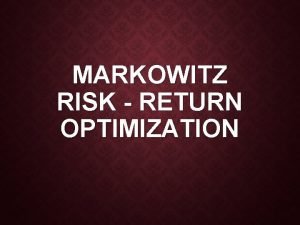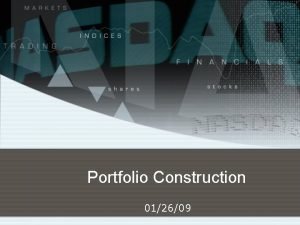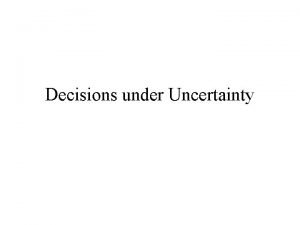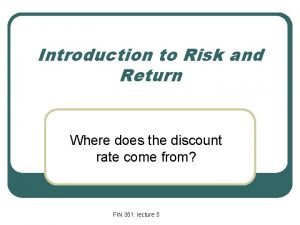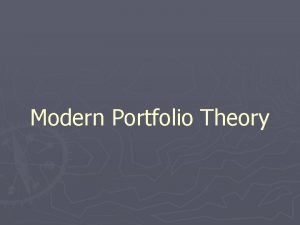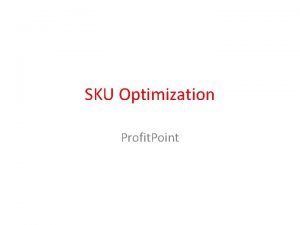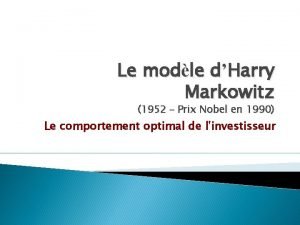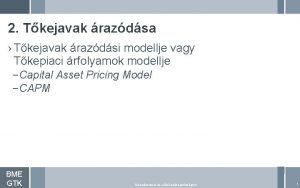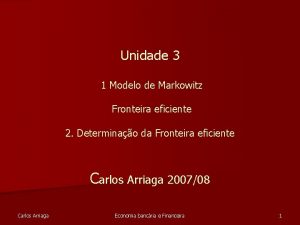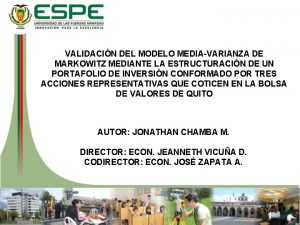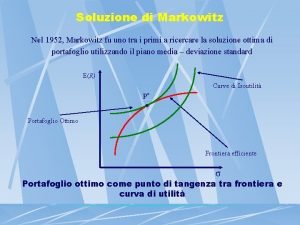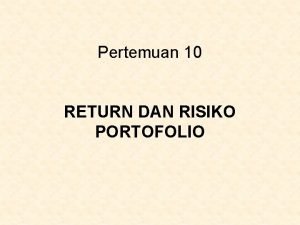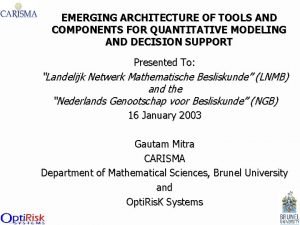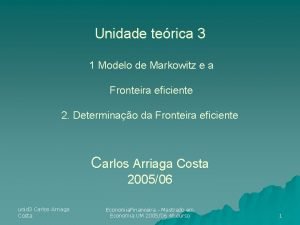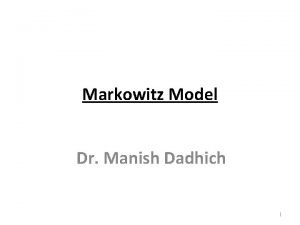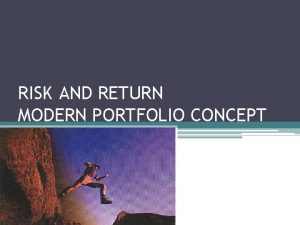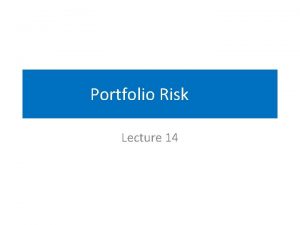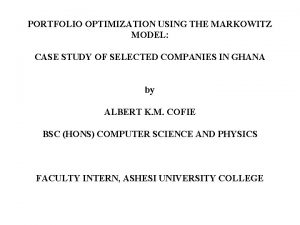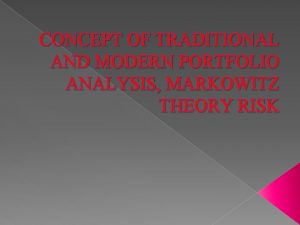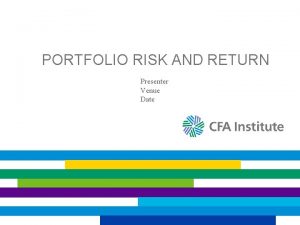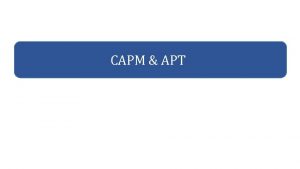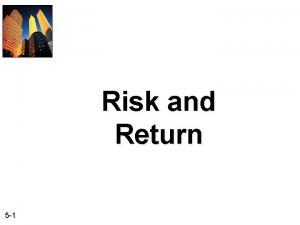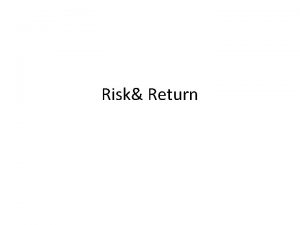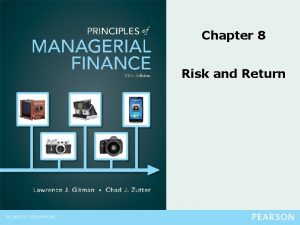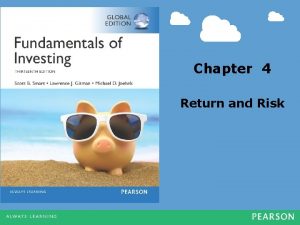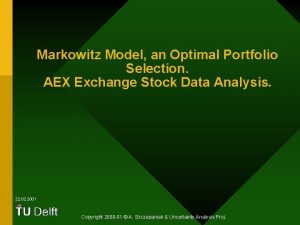MARKOWITZ RISK RETURN OPTIMIZATION INTRODUCTION Modern portfolio theory
















- Slides: 16

MARKOWITZ RISK - RETURN OPTIMIZATION

INTRODUCTION • Modern portfolio theory was fathered by Harry Markowitz in the 1950 s • It assumes that an investor wants to maximize a portfolio's expected return contingent on any given amount of risk, with risk measured by the standard deviation of the portfolio's rate of return • Achieving a higher expected return requires taking on more risk, so investors are faced with a trade-off between risk and expected return

• This risk-expected return relationship of efficient portfolios is graphically represented by a curve known as the efficient frontier • All efficient portfolios, each represented by a point on the efficient frontier, are well-diversified.

• This graph shows expected return (vertical) versus standard deviation. This is called the 'risk-expected return space‘ • Every possible combination of risky assets, can be plotted in this risk-expected return space, and the collection of all such possible portfolios defines a region in this space • The left boundary of this region is a hyperbola, and the upper edge of this region is the efficient frontier in the absence of a riskfree asset (sometimes called "the Markowitz bullet")

• Combinations along this upper edge represent portfolios (including no holdings of the risk-free asset) for which there is lowest risk for a given level of expected return • Equivalently, a portfolio lying on the efficient frontier represents the combination offering the best possible expected return for given risk level • The tangent to the hyperbola at the tangency point indicates the best possible capital allocation line (CAL)

• By the diagram, the introduction of the risk-free asset as a possible component of the portfolio has improved the range of risk-expected return combinations available • Everywhere except at the tangency portfolio the half-line gives a higher expected return than the hyperbola does at every possible risk level • The fact that all points on the linear efficient locus can be achieved by a combination of holdings of the risk-free asset and the tangency portfolio is known as the one mutual fund theorem, where the mutual fund referred to is the tangency portfolio

MODERN PORTFOLIO THEORY • Modern portfolio theory (MPT), or mean-variance analysis, is a mathematical framework for assembling a portfolio of assets such that the expected return is maximized for a given level of risk, defined as variance • Its key insight is that an asset's risk and return should not be assessed by itself, but by how it contributes to a portfolio's overall risk and return • MPT assumes that investors are risk averse, meaning that given two portfolios that offer the same expected return, investors will prefer the less risky one • Thus, an investor will take on increased risk only if compensated by higher expected returns

• Conversely, an investor who wants higher expected returns must accept more risk • The exact trade-off will be the same for all investors, but different investors will evaluate the trade-off differently based on individual risk aversion characteristics • The implication is that a rational investor will not invest in a portfolio if a second portfolio exists with a more favorable riskexpected return profile – i. e. , if for that level of risk an alternative portfolio exists that has better expected returns • Two models under risk – return are: • Portfolio return is the proportion-weighted combination of the constituent assets' returns. • Portfolio volatility is a function of the correlations ρij of the component assets, for all asset pairs (i, j)

TWO MUTUAL FUND THEOREM • One key result of the above analysis is the two mutual fund theorem • This theorem states that any portfolio on the efficient frontier can be generated by holding a combination of any two given portfolios on the frontier; the latter two given portfolios are the "mutual funds" in theorem's name • So in the absence of a risk-free asset, an investor can achieve any desired efficient portfolio even if all that is accessible is a pair of efficient mutual funds

RISK-FREE ASSET AND THE CAL • The risk-free asset is the (hypothetical) asset that pays a risk-free rate • In practice, short-term government securities (such as US treasury bills) are used as a risk-free asset, because they pay a fixed rate of interest and have exceptionally low default risk • The risk-free asset has zero variance in returns (hence is riskfree); it is also uncorrelated with any other asset • As a result, when it is combined with any other asset or portfolio of assets, the change in return is linearly related to the change in risk as the proportions in the combination vary

• When a risk-free asset is introduced, the half-line shown in the figure is the new efficient frontier. It is tangent to the hyperbola at the pure risky portfolio with the highest Sharpe ratio • Capital Allocation Line’s (CAL) formula is as given below: • In this formula P is the sub-portfolio of risky assets at the tangency with the Markowitz bullet, F is the risk-free asset, and C is a combination of portfolios P and F

ASSET PRICING • Above analysis describes optimal behavior of an individual investor • Since everyone holds the risky assets in identical proportions to each other - namely in the proportions given by the tangency portfolio - in market equilibrium the risky assets' prices, and therefore their expected returns, will adjust so that the ratios in the tangency portfolio are the same as the ratios in which the risky assets are supplied to the market • Thus relative supplies will equal relative demands • MPT derives the required expected return for a correctly priced asset in this context

SYSTEMATIC RISK AND SPECIFIC RISK • Specific risk is the risk associated with individual assets - within a portfolio these risks can be reduced through diversification (specific risks "cancel out") • Specific risk is also called diversifiable, unique, unsystematic, or idiosyncratic risk • Systematic risk (a. k. a. portfolio or market risk) refers to the risk common to all securities - except for selling short, systematic risk cannot be diversified away (within one market) • Within the market portfolio, asset specific risk will be diversified away to the extent possible

• Systematic risk is therefore equated with the risk of the market portfolio • Systematic risks within one market can be managed through a strategy of using both long and short positions within one portfolio, creating a "market neutral" portfolio • Market neutral portfolios, therefore will have a correlations of zero.

CAPITAL ASSET PRICING MODEL • The asset return depends on the amount paid for the asset today. The price paid must ensure that the market portfolio's risk / return characteristics improve when the asset is added to it • The CAPM is a model that derives theoretical required expected return (i. e. , discount rate) for an asset in a market, given the risk-free rate available to investors and the risk of the market as a whole • The CAPM is usually expressed:

• Beta, is the measure of asset sensitivity to a movement in the overall market; Beta is usually found via regression on historical data • Betas exceeding one signify more than average "riskiness" in the sense of the asset's contribution to overall portfolio risk; betas below one indicate a lower than average risk contribution • [ E(Rm) – Rf ] is the market premium, the expected excess return of the market portfolio's expected return over the risk-free rate
 Markowitz risk return optimization
Markowitz risk return optimization Markowitz portfolio construction process
Markowitz portfolio construction process Markowitz risk premium
Markowitz risk premium Introduction to risk and return
Introduction to risk and return Modern portfolio theory
Modern portfolio theory History of modern portfolio theory
History of modern portfolio theory Credit risk market risk operational risk
Credit risk market risk operational risk Sku portfolio optimization
Sku portfolio optimization Markowitz nobel
Markowitz nobel Dina markowitz
Dina markowitz Markowitz modell
Markowitz modell Teorema de markowitz
Teorema de markowitz Portafolio markowitz
Portafolio markowitz Modello di markowitz
Modello di markowitz Analisis risiko portofolio
Analisis risiko portofolio Markowitz diversification
Markowitz diversification Modelo de markowitz
Modelo de markowitz
